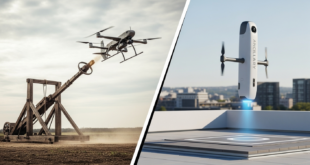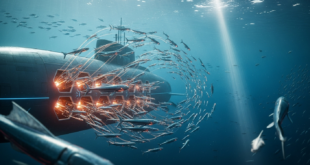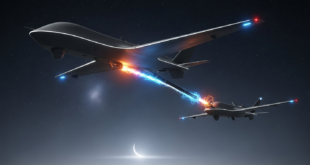Introduction
The future of underwater warfare is being reshaped by cutting-edge missile technologies that promise to redefine naval combat. Supersonic anti-ship missile torpedoes and missile-assisted torpedoes represent a groundbreaking convergence of high-speed missile capabilities with advanced underwater propulsion systems. These innovative weapons systems are designed to rapidly close the gap between adversaries, overwhelm enemy defenses, and deliver devastating payloads with unprecedented precision and speed. As naval strategies evolve in response to emerging threats, these transformative technologies are poised to play a critical role in modernizing underwater warfare.
Torpedoes: Transforming Underwater Warfare with Advanced Technology
Torpedoes have long been the primary weapons of submarines and anti-submarine warfare platforms, serving as the backbone of naval combat. These self-propelled, guided projectiles operate underwater, designed to detonate on contact or in proximity to a target. Historically, torpedoes played a decisive role during World War II, sinking major warships with just one or two well-placed hits. Today, modern torpedoes can engage targets at ranges up to 40 km and speeds around 50 knots, enabling submarines to effectively counter both surface and undersea threats while providing surface ships and aircraft with the means to launch precision underwater attacks.
Advancements in torpedo technology have led to significant improvements in both performance and tactical versatility. Torpedoes are typically classified as lightweight(air-dropped or rocket-delivered) or heavyweight(submarine or ship-launched), with lightweight torpedoes primarily used in anti-submarine warfare (ASW) due to their smaller warheads, shorter range, and reduced endurance, while heavyweight torpedoes, deployed from submarines or ships, are designed for longer-range engagements.
They can also be launched from a variety of platforms like ships, submarines, rotary wing and fixed-wing aircraft. The range of the Lightweight torpedoes is further enhanced when delivered by aircraft or rocket, and typically have a warhead in the 40kg range. A lightweight torpedo is designed to be dropped very close to the target, and therefore has no wire guidance and frequently begins a programmed search pattern on entering the water.
Innovations in guidance systems have produced both wire-guided and autonomous fire-and-forget variants, while propulsion enhancements have improved speed, maneuverability, and operational depth.
Notable examples of these advancements include the U.S. Navy’s MK 54 Lightweight Torpedo, which weighs approximately 276 kg and can be launched from various platforms, including surface ships, helicopters, and fixed-wing aircraft. This torpedo features a high-explosive warhead and a liquid-propellant propulsion system that enables it to achieve speeds of around 40 knots. In Europe, the A244/S Mod 3 lightweight torpedo from EuroTorp offers advanced acoustic guidance and counter-countermeasures, ensuring effective performance at depths exceeding 600 meters with a top speed of 36 knots. The Franco-Italian MU90 represents a new generation of lightweight torpedoes, designed to counter a wide variety of submarine threats, and is lauded for its comprehensive range of search and attack modes, as well as its compatibility with multiple launch platforms. By incorporating advanced guidance, propulsion, and safety systems, modern torpedoes provide unparalleled flexibility and operational superiority, ensuring that naval platforms can adapt to evolving threats and maintain strategic dominance in contested maritime environments. Moreover, integrating torpedoes as payloads in missile-assisted systems allows for rapid, long-range delivery of these lethal weapons to target areas, significantly extending their operational reach.
Supersonic Anti-Ship Missile Torpedoes and Missile Assisted Torpedoes
At the core of these new systems is the integration of supersonic missile technology with torpedo design. Traditional torpedoes, while effective, have been limited by relatively slow speeds and predictable trajectories, making them vulnerable to advanced countermeasures. In contrast, supersonic anti-ship missile torpedoes combine the speed of supersonic missiles with the precision of guided torpedoes, enabling them to rapidly target and engage enemy vessels before defensive systems can react. Missile-assisted torpedoes further enhance this capability by utilizing a missile to deliver a torpedo to the vicinity of a target, where the torpedo then takes over with high-precision tracking and guidance. This two-stage approach significantly increases the likelihood of successful penetration of enemy defenses, even in heavily contested environments.
Two promising concepts—supersonic anti-ship missile torpedoes and missile-assisted torpedoes—are poised to redefine naval combat by closing distances rapidly and striking targets with unprecedented accuracy. Although these systems share a common goal of enhancing underwater engagement, they differ in their operational approaches and technical implementations, offering unique advantages and tradeoffs for modern naval forces.
Missile Assisted Torpedoes
Missile-assisted torpedoes employ a two-stage delivery system. In this concept, a supersonic missile is used to deliver a torpedo payload to the target vicinity, dramatically extending the range and reducing the exposure of the torpedo to enemy countermeasures. Once the missile reaches the designated area, the torpedo is released and activated, engaging its own autonomous guidance system to home in on the target underwater. This separation of roles allows the missile to handle the high-speed transit phase, while the torpedo, optimized for underwater navigation, takes over the final approach and attack. This two-tiered strategy addresses the inherent limitations of conventional torpedoes—such as slower speeds and shorter ranges—by combining the rapid delivery of missile technology with the precision of torpedo guidance.
Supersonic Anti-Ship Missile Torpedoes
Supersonic anti-ship missile torpedoes represent a novel integration of missile and torpedo technologies into a single, high-speed weapon system. These advanced systems are engineered to travel at supersonic speeds above water, rapidly closing the gap to high-value maritime targets. Upon reaching a predetermined point, the missile transitions seamlessly into a torpedo mode, guided by sophisticated sensors and control algorithms to navigate underwater and engage enemy vessels. This all-in-one solution aims to combine the rapid approach and surprise factor of missiles with the effective underwater maneuverability and precision of torpedoes. While still largely in experimental phases, this technology holds the promise of overwhelming enemy defenses by leveraging high-speed propulsion and integrated guidance systems that operate effectively across both air and water environments.
Strategic and Operational Implications
The primary difference between the two systems lies in their operational execution and integration. Supersonic anti-ship missile torpedoes are designed as a unified system, merging the capabilities of a missile and a torpedo into one seamless package, thereby reducing the number of deployment stages and potentially increasing the element of surprise. Conversely, missile-assisted torpedoes separate the delivery and engagement phases, allowing each component to be optimized for its specific role. This separation can lead to greater flexibility in tactical deployment, as the missile can be tailored for long-range, high-speed transit, while the torpedo can focus on precision targeting and underwater maneuverability.
These innovations carry profound strategic implications. Both systems are poised to significantly enhance the effectiveness of underwater warfare by reducing the reaction time of adversaries and increasing the likelihood of a successful strike on high-value targets. They also force a rethinking of naval defense strategies, as adversaries must now contend with weapons that can bypass conventional countermeasures and operate seamlessly across the air-to-water interface. As these technologies mature, they are set to redefine maritime combat, providing a decisive edge in maintaining naval superiority in an increasingly contested global environment.
The deployment of these advanced systems is set to revolutionize naval warfare by providing a decisive edge in both offensive and defensive operations. For instance, the supersonic capabilities enable rapid engagement of high-value targets such as aircraft carriers and destroyers, reducing reaction times and creating tactical surprise. Moreover, missile-assisted torpedoes allow for extended reach and flexibility in complex operational scenarios, giving naval commanders the ability to strike from unexpected angles and at greater distances. This enhanced lethality, combined with improved maneuverability and reduced detection risk, marks a significant departure from traditional underwater warfare tactics.
The strategic implications of these innovations extend far beyond individual battles. As adversaries upgrade their naval defenses and invest in countermeasures, the ability to deploy supersonic and missile-assisted torpedoes could tilt the balance in underwater warfare, reshaping global maritime power dynamics. Nations that adopt these cutting-edge systems will gain a critical advantage in deterrence and power projection, potentially altering naval doctrines and procurement strategies worldwide. This evolution in weaponry underscores the increasing importance of rapid, high-precision, and stealthy underwater combat capabilities in an era where traditional naval engagements are being transformed by technological innovation.
China’s Supersonic Anti-Ship Missile Torpedo: A Game-Changer in Naval Warfare
China is making significant strides in transforming underwater warfare with its development of a supersonic anti-ship missile torpedo. This innovative system is designed to combine the rapid speed of a supersonic missile with the precision of a guided torpedo, offering a versatile, cross-media weapon that can traverse both air and water with lethal efficiency. The missile, measuring approximately 5 meters in length, is engineered to cruise at 2.5 times the speed of sound at altitudes comparable to commercial airliners—around 10,000 meters—for up to 200 kilometers. Once it reaches the target vicinity, typically within 10 kilometers, the missile transitions into torpedo mode, ejecting its payload into the water where it activates its own guidance system to pursue and engage enemy submarines.
The technical innovation behind this system lies in its unique propulsion and power management capabilities. One of the most challenging aspects of designing a cross-media weapon is developing a power system that can generate substantial thrust while operating efficiently in both air and water. Chinese researchers have addressed this by developing a boron-powered ramjet engine, which stands out for its ability to function in two very different environments. By significantly increasing the boron content in the fuel—doubling its typical share compared to conventional air-breathing missiles—the engine achieves greater thrust in water than would be possible with aluminum-based fuels. Unique components such as adjustable inlets and exhaust nozzles ensure that the boron’s burn efficiency is maintained, whether the system is navigating the thin atmosphere or the dense medium of seawater.
Operationally, the missile-assisted torpedo system provides a dramatic improvement in both range and penetration capability. By employing supercavitation technology, the torpedo generates a large air bubble around itself, drastically reducing drag and enabling underwater speeds of up to 100 meters per second (approximately 200 knots). This allows the torpedo to rapidly close in on its target while retaining the ability to change course or perform a crash dive to depths of up to 100 meters, effectively evading countermeasures. This dual-mode operation not only extends the engagement range beyond traditional torpedo limits but also enhances the missile’s overall stealth and survivability against modern naval defenses.
The strategic implications of this breakthrough are profound. In an era marked by increasing underwater threats and rapidly evolving naval technologies, a supersonic anti-ship missile torpedo could significantly tilt the balance of power at sea. By combining the speed and reach of missile technology with the precision and endurance of torpedoes, China is poised to gain a critical edge in anti-ship and anti-submarine warfare. This development not only underscores China’s commitment to enhancing its naval capabilities but also raises the stakes for global maritime security, prompting a re-evaluation of defense strategies by rival nations.
DRDO Successfully Flight Tests Supersonic Missile Assisted Release of Torpedo
In a significant leap forward for naval warfare, the Defence Research and Development Organisation (DRDO) has successfully flight tested a supersonic missile that carries and releases a lightweight torpedo—an innovation that promises to redefine anti-submarine warfare capabilities. This breakthrough system, known as the Supersonic Missile Assisted Release of Torpedo (SMART), combines the rapid delivery of a supersonic missile with the precision of an autonomous torpedo. Designed to cover around 350 nautical miles at supersonic speeds, SMART is engineered to approach a submerged enemy submarine before ejecting its torpedo warhead, which then uses advanced acoustic homing to engage its target.
The SMART system represents a quantum leap in anti-submarine capabilities. Developed over several years, the missile is launched from a warship or a truck-based coastal battery and behaves like a conventional supersonic missile during its high-speed transit phase. As it nears the target, the missile seamlessly transitions by ejecting the Torpedo Advanced Light (TAL)—also known as Shyena—into the water. This lightweight, high-performance torpedo, with an endurance of roughly six minutes and an operational range of around 10 miles at 33 knots, then takes over to precisely track and destroy enemy submarines. The success of SMART’s flight test not only demonstrates the potential of this innovative technology but also sets the stage for a new era in underwater warfare.
The strategic implications of this breakthrough are profound. With increasing threats from advanced submarine fleets and a shifting maritime security landscape—exacerbated by regional rivalries—enhanced anti-submarine systems like SMART provide a critical deterrent. The integration of supersonic missile delivery with autonomous torpedo guidance dramatically reduces reaction times, improves engagement range, and minimizes the risk of detection, offering a decisive edge over conventional systems. As nations invest in upgrading their naval capabilities, such innovations are poised to transform the balance of power in underwater operations.
Looking to the future, the successful development of SMART is likely to spur further innovation in missile-assisted torpedo technologies. Global competitors, including China, are actively exploring similar concepts, which underscores the escalating importance of advanced battery and propulsion systems in modern naval warfare. As these technologies mature, we can expect them to drive a new generation of anti-submarine and anti-ship capabilities that will shape the strategic landscape for decades to come.
In conclusion, DRDO’s successful flight test of the SMART system marks a transformative moment for underwater warfare. By harnessing the speed of supersonic missiles and the precision of autonomous torpedoes, this breakthrough technology enhances the Navy’s ability to counter underwater threats and reinforces national security. As deployment plans progress, SMART is set to become a key asset in modern naval arsenals, paving the way for further advancements that will redefine future maritime combat.
Royal Navy Long Range ASW Weapon
The Royal Navy’s call for a new Long Range Anti-Submarine Warfare (LRAW) weapon is centered on developing a system capable of transforming underwater engagement. It is a missile-assisted torpedo system. In this design, a supersonic missile is used to rapidly deliver a lightweight torpedo warhead to the vicinity of the target. Once the missile reaches the designated area, it ejects the torpedo into the water, where the torpedo then activates its own guidance system to home in on and engage the enemy.
Key requirements include compatibility with the Mk41 Vertical Launch System (VLS), which is crucial for integrating the new LRAW concept onto future Type 26 and Type 31 frigates. This system is designed to be a missile-delivered, rocket-assisted platform that can deploy lightweight torpedoes with extended engagement ranges—significantly surpassing the capabilities of current heavy torpedoes. The missile/rocket system is expected to provide rapid, stand-off strike capabilities, enhancing the Navy’s ability to counter submarine threats in contested maritime environments.
The envisioned LRAW system will enable extended-range anti-submarine attacks by delivering torpedoes that can autonomously engage targets after release. By incorporating advanced guidance, sensor fusion, and autonomous control technologies, the system is designed to operate effectively in diverse underwater conditions. This will ensure that torpedoes are not only capable of precise target tracking but can also navigate complex acoustic environments. Furthermore, the system aims to support a total stockpile requirement of approximately 500 missiles, reflecting the Navy’s commitment to a scalable and sustainable approach to future anti-submarine warfare.
In addition to technical performance, the integration of the Mk41 VLS is a strategic move that underscores the Royal Navy’s broader modernization efforts. While current platforms, such as the Type-45 destroyers, rely on older VLS configurations like the Sylver system, the future Type 26 and Type 31 frigates will incorporate the Mk41 launcher to accommodate a versatile range of missile types. This shift is expected to provide a significant upgrade in terms of interoperability, system performance, and overall operational flexibility, ensuring that the Royal Navy remains at the forefront of maritime defense innovation in an increasingly contested global environment.
Conclusion
Supersonic anti-ship missile torpedoes and missile-assisted torpedoes are set to redefine the future of underwater warfare by combining unparalleled speed, precision, and operational flexibility. As these systems move from development to deployment, they promise to enhance naval capabilities, disrupt enemy defenses, and establish new strategic paradigms on the high seas. With global naval powers racing to integrate these innovations into their arsenals, the next generation of underwater combat is poised to be more dynamic, lethal, and transformative than ever before.
References and resources also include:
 International Defense Security & Technology Your trusted Source for News, Research and Analysis
International Defense Security & Technology Your trusted Source for News, Research and Analysis



